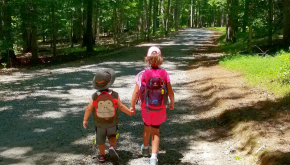
by Kiersten Ahrns, National Association of State Foresters intern & Ohio State University undergraduate
For many families, land can be the glue holding the family together. In Virginia, landowners value their forests for multiple reasons, including wildlife, recreation, timber, and hunting. The vast majority of Virginia woodland owners want to pass their woodlands forward to the next generation. But less than 2% have a written succession or estate plan. These statistics are not unique to Virginia. Are you prepared to pass your forest land on to the next generation? Do you know what is needed to keep you land intact and in family ownership?
Land succession planning is one of the hardest and most important components of land ownership. No one wants to discuss death, taxes, or what will happen during land transfers. But the cost of not planning puts your land's future in jeopardy. Without successional planning, your land and legacy face an uncertain future. By researching and planning ahead, you can ensure your wishes are met, minimize the financial costs and emotional challenges, and secure your woodland for generations to come.
To address challenges of generational planning, the Virginia Department of Forestry (VDOF) and Virginia Cooperative Extension (VCE) partnered to create the Generation NEXT program. Each year, the award-winning program provides 2-4 affordable succession planning workshops across the state, with free legal guidance from legal and financial professionals and landowner testimonials to inspire and equip landowners with legacy planning knowledge.
Because women are more likely to complete forest legacy plans, getting them involved was important to Generation NEXT project leads Adam Downing and Mike Santucci. Women play an important role in the planning process but are less likely to participate in woodland oriented workshops. Generation NEXT workshops are structured with affordable fees for couples, encouraging women to participate.
Mike Santucci, VDOF Forestland Conservation Program Manager, didn’t initially recognize the importance of succession planning in the context of woodland management. Over time, he saw the need to expand the program’s sphere of influence. “As I worked with more family woodland owners, I saw a fundamental need to address the intergenerational transfer of their land so their ethic and good management was sustained beyond their tenure.” Santucci also feels compelled to give back to the resource and the profession. “This topic is important to ensure future foresters have a land base where they can practice the profession we love. I try to impart passion for the program to younger foresters so that we can continue to assist landowners for generations.”
For many landowners, starting to plan for the next generation is difficult. Fortunately, foresters can be a trusted professional resource when initiating this topic with landowners.
“It takes a personal commitment to prioritize this type of planning as critically important,” VCE Forestry Agent Adam Downing said. “It also takes dedication to push through the challenges to get to the place where both the family and the land are on a good trajectory.”
Generation NEXT recommends several steps, adapted from the Oregon State University “Ties to the Land” Program, including:
1. Discuss and write down goals for the property and the family.
2. Discuss these written goals with your family.
3. Explore options for a family business entity to own the land.
4. Have regular family meetings to discuss the business and share your passion.
5. Set family employment policies before you hire any family members.
6. Discuss and write down important decisions.
7. Create non-financial reasons for the family to keep the property.
8. Get your kids and grandkids out to work and have fun on the property.
9. Create a governance structure that will survive your passing.
10. Remember to have fun!
Millions of acres of family-owned forest land will change hands in the coming decades. These lands are vulnerable to fragmentation and parcelization. Have you done everything you can to keep woodlands intact and in your family? By starting the conversation and beginning the learning process, you can ensure forests stay within your family for generations.

